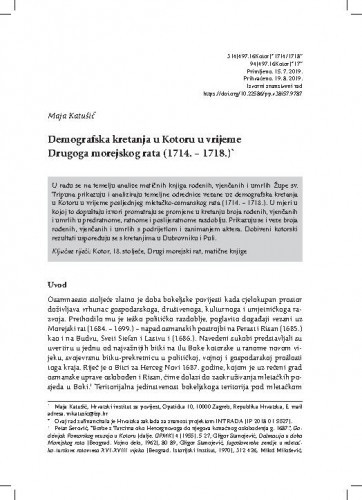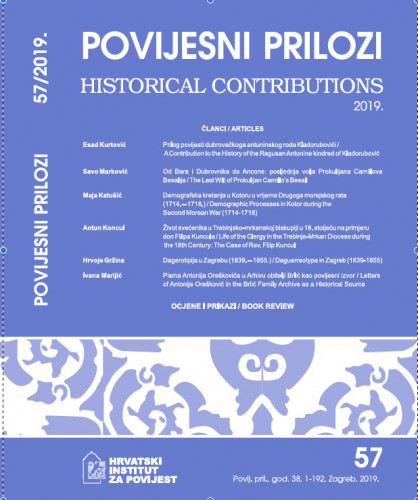U radu se na temelju analize matičnih knjiga rođenih, vjenčanih i umrlih Župe sv. Tripuna prikazuju i analiziraju temeljne odrednice vezane uz demografska kretanja u Kotoru u vrijeme posljednjeg mletačko-osmanskog rata (1714. – 1718.). U mjeri u kojoj to dopuštaju izvori promatraju se promjene u kretanju broja rođenih, vjenčanih i umrlih u predratnome, ratnome i poslijeratnome razdoblju. Prikazuju se i veze broja rođenih, vjenčanih i umrlih s podrijetlom i zanimanjem aktera. Dobiveni kotorski rezultati uspoređuju se s kretanjima u Dubrovniku i Puli.; Based on the birth, marriage, and death records in the parish of St Tryphon in Kotor, the paper presents and analyses the key determinants of local demographic trends during the last Venetian-Ottoman war (1714-1718). To the extent permitted by the sources, the author has focused on the fluctuations in the number of births, marriages, and deaths in the pre-war, wartime, and post-war periods. Links between these numbers have been juxtaposed to the origins and professions of the persons involved and the results obtained from Kotor have been compared with the trends in Dubrovnik and Pula. These comparisons indicate that – although the Second Morean War was not fought in the immediate vicinity of Kotor – the war events had a considerable bearing on the town’s demographic trends. This is particularly evident in the mortality rate, which rose steeply when the war was most intense. Military migrations, that is, the arrival of soldiers in the town, also increased the biological potential of the population, which led to an increase in the marriage rate. These trends reveal Kotor’s military profile and show the soldiers (and their migrations) as an interesting social group.
Sažetak

 Povijesni prilozi : Historical contributions : 38,57(2019) / Hrvatski institut za povijest ; glavna i odgovorna urednica, Chefredacteur, editor-in-chief Irena Benyovsky Latin.
Povijesni prilozi : Historical contributions : 38,57(2019) / Hrvatski institut za povijest ; glavna i odgovorna urednica, Chefredacteur, editor-in-chief Irena Benyovsky Latin.